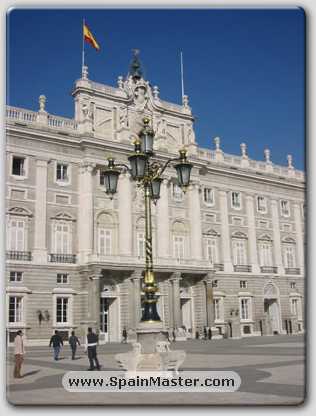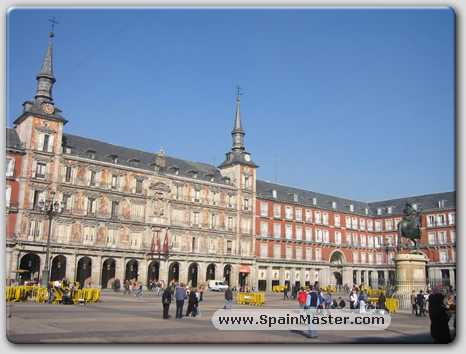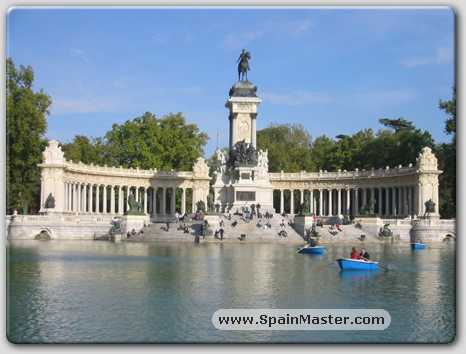
The population of the city was 3.228 million (July 2005), while the estimated urban area population is 5.078 million. The entire population of the Madrid metropolitan area (urban area and suburbs) is calculated to be 5.843 million. The city spans a total of 607 km² (378 square miles).
As the former capital of the old Spanish Empire, Madrid has been bestowed with a degree of cultural predominance. Museums such as Museo del Prado, the Museo Reina Sofia, and the Museo Thyssen-Bornemisza are major tourist attractions in the city. Other cultural highlights include the Royal Palace of Madrid.
The Inner City. - The form of Madrid proper (exclusive of the modern suburbs) is almost that of a square with the corners rounded off ; from east to west it measures rather less than from north to south. It was formerly surrounded by a poor wall, partly of brick, partly of earth, some 20 ft. in height, and pierced by five principal gates (puertas) and eleven doorways (portillos). Of these only three, the Puerta de Alcala on the east, the Puerta de Toledo on the south and the Portillo de San Vicente on the west, actually exist; the first and the third were erected in the time of Charles III. (1759-1788), and the second in honour of the restoration of Ferdinand VII. (1827). The Manzanares - or rather its bed, for the stream is at most seasons of the year quite insignificant - is spanned by six bridges, the Puente de Toledo and Puente de Segovia being the chief.

The Puerta del Sol is the centre of Madrid, the largest of its many plazas, and the place of most traffic. It derived its name from the former east gate of the city, which stood here until 1570, and had on its front a representation of the sun. On its south side stands the Palacio de la Gobernacion, or ministry of the interior, a heavy square building by a French architect, J. Marquet, dating from 1768. From the Puerta del Sol diverge, immediately or mediately, ten of the principal streets of Madrid - eastward by north, the Calle de Alcala, terminating beyond the Buen Retiro park; eastward, the Carrera de San Jeronimo, terminating by the Plaza de las Cortes in the Prado; southward, the Calle de Carretas; westward, the Calle Mayor, which leads to the council chamber and to the palace, and the Calle del Arenal, terminating in the Plaza de Isabel II. and the royal opera house; north-westward, the Calles de Preciados and Del Carmen; and northward, the Calle de la Montera, which afterwards divides into the Calle de Fuencarral to the left and the Calle de Hortaleza to the right. The contract for another wide street through central Madrid, to be called the Gran Via, was given to an English firm in 1905.
The Calle de Alcala is bordered on both sides with acacias, anti contains the Real Academia de Bellas Artes, founded in 1752 as an academy of art and music; its collection of paintings by Spanish masters includes some of the best-known works of Murillo. The handsome Bank of Spain (1884-1891)stands where the Calle de Alcala meets the Prado; in the oval Plaza de Madrid, at the same point, is a fine 18th-century fountain with a marble group representing the goddess Cybele drawn in a chariot by two lions. The Calle de Alcala is continued eastward past the Buen Retiro gardens and park, and through the Plaza de Independencia, in the middle of which is the Puerta de Alcala. The Plaza de las Cortes is so called from the Congreso de los Diputados, or House of Commons, on its north side. The square contains a bronze statue of Cervantes, by Antonio Sola, erected in 1835. The Calle de Carretas, on the west side of which is the General Post Office, ranks with the Carrera de San Jeronimo and Calle de la Montera for the excellence of its shops. From the Calle Mayor is entered the PlazaMayor,a rectangle of about 430 ft.by 330 ft., formerly the scene of tournaments, bull fights, autos de fe, acts of canonization (including that of Ignatius Loyola in 1622) and similar exhibitions, which used to be viewed by the royal family from the balcony of one of the houses called the Panaderia (belonging to the guild of bakers). The square, which was built under Philip III. in 1619, is surrounded by an arcade; the houses are uniform in height and decoration. In the centre stands a bronze equestrian statue of Philip III., designed by Giovanni da Bologna, after a painting by Pantoja de la Cruz, and finished by Pietro Tacca. From the southeast angle of the Plaza Mayor the Calle de Atocha,one of the principal thoroughfares of Madrid, leads to the outskirts of the inner city; it contains two large hospitals and part of the university buildings (faculty of medicine). The house occupied by Cervantes from 1606 until his death in 1616 stands at the point where it meets the Calle de Leon ; in this street is the Real

Academia de la Historia, with a valuable library and collections of MSS. and plate. From the southwest angle of the Plaza Mayor begins the Calle de Toledo, the chief mart for the various woollen and silken fabrics from which the picturesque costumes peculiar to the peninsula are made. In the Plaza de Isabel II., at the western extremity of the Calle del Arenal, stands the royal opera-house, the principal front of which faces the Plaza del Oriente and the royal palace. In the centre of the plaza is a fine bronze equestrian statue of Philip I V. (1621-1665) ; it was designed by Velazquez and cast by Tacca, while Galileo is said to have suggested the means by which the balance is preserved. The gift of the grand duke of Tuscany in 1640, it stood in the Buen Retiro gardens until 1844.

More information:
SpainMaster (en.)- a guide to Madrid, Barcelona, Costa Blanca and many more places in Spain with reviews and information
Spanialink (no.) - en guide til Spania; overnatting, leiebil, flybilletter, fakta og gode råd og tips.